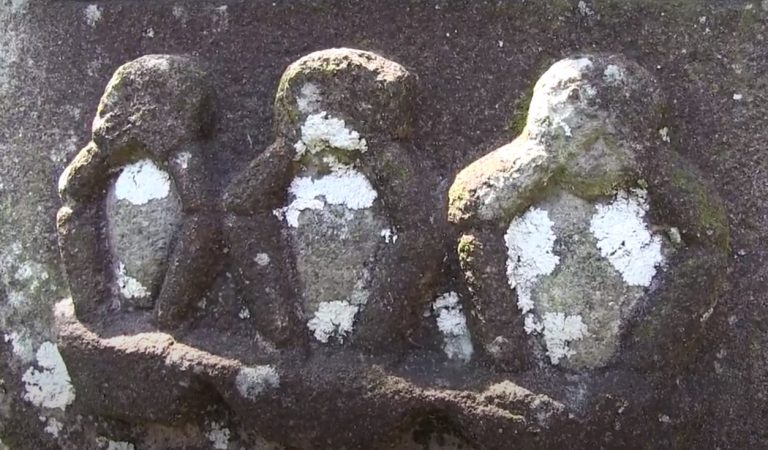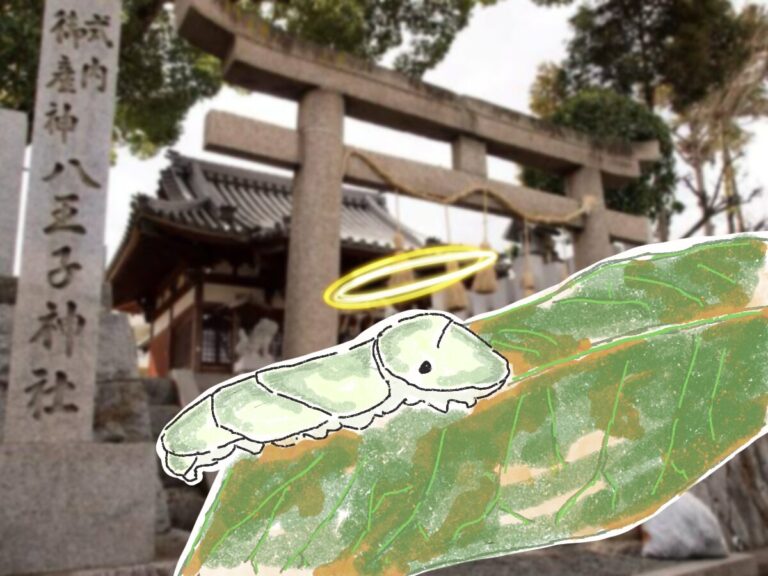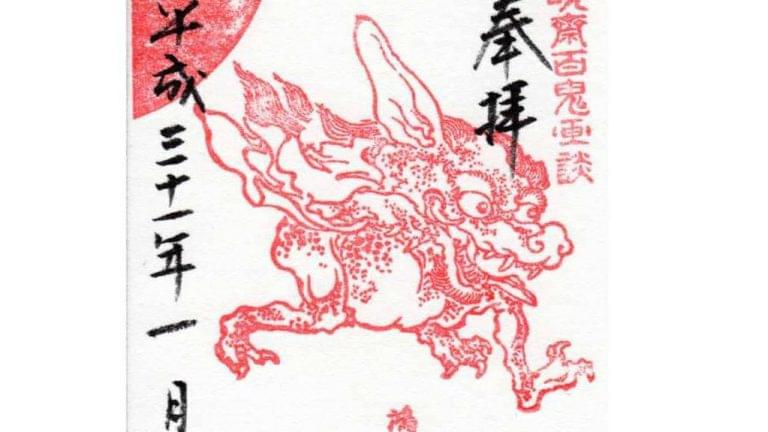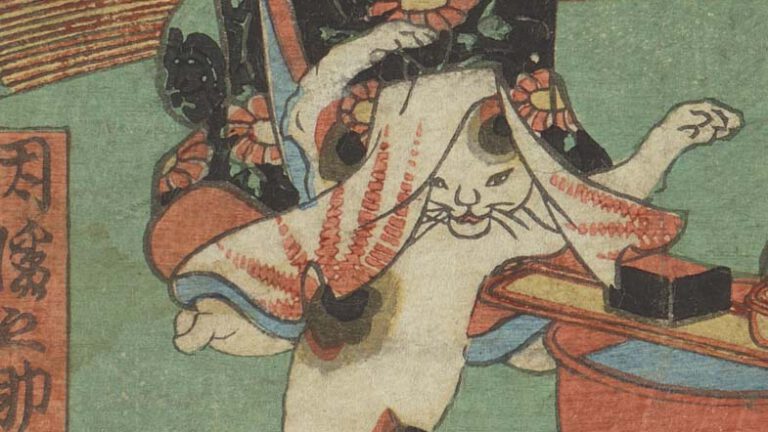Hey, hey. My name is Thersa Matsuura, author of the Book of Japanese Folklore and podcaster here at Uncanny Japan, where I tell you about the more obscure nooks and crannies of Japanese culture.
Pop quiz. What’s the tallest mountain in Japan?
Mount Fuji. Good.
When was the last time Mount Fuji erupted? Ah, that would be the end of 1707 through 1708.
When is it going to erupt again? Well, there’s no telling, because while it’s dormant, it’s still considered an active volcano. Remember that when you’re trekking up that rocky slope or sitting in a cafe in Hakone, drinking green tea, and taking in that breathtaking view that has inspired poets, writers, and artists all through history? Today I’m going to touch on some Mount Fuji basics, but then I’m going to tell you an absolutely wild myth about the goddess enshrined there, and a bizarre little legend about Enno Gyoja, a mountain ascetic who licks swords.
The Japanese Wisdom About Climbing Mount Fuji
Let’s start with a very well-known and humorous Japanese saying about Mount Fuji, one that you’ll hear a lot if you bring up the mountain in conversation.
That is, “Ichido mo noboru nu baka. Nido noboru baka.”
Something like, “Those who never climb Mount Fuji even once are fools, but those who climb Mount Fuji more than once are also fools.”
Yes, if you have the opportunity, definitely climb Japan’s tallest and most famous of mountains, but you’ll soon learn it’s not a beautiful climb. Treeless, and you’re walking on lava rock, and I don’t know about now, but it used to be pretty littered with trash.
The view is outstanding, though, but for me, once was enough. I’d much rather sit in that cafe in Hakone, drinking a matcha latte and relishing in its splendor.
A Personal Mount Fuji Climbing Experience
So yes, I did climb, but I wasn’t smart about it. A group of university friends invited me, saying that we wouldn’t climb if it was raining. It was midsummer and really hot at the bottom of the mountain, but the weather looked quite cloudy, so I just assumed that we weren’t going to climb.
I really don’t know why I thought that when I piled into the van with a half a dozen friends, all decked out in mountain climbing gear, backpacks, little handheld oxygen canisters. I really should have gone back and grabbed a jacket, the very least. I was in short sleeves.
The plan was to climb all night so we could see the sunrise at the top. That was a very popular way to climb Fuji back then in the early 90s, but I just read that now it’s called bullet climbing, and it’s extremely frowned upon. Also, the gates that let you up onto one of the four climbing paths actually close early to prevent bullet climbing. You’re encouraged to go early and stay the night, or some hours resting or sleeping in one of the lodgings along the way. I recommend that.
Adapting to the altitude is important. Long story short, I nearly froze to death on top of getting altitude sickness at the eighth station, where I dramatically swore I’d pay for a helicopter to come and get me. Would someone please call one? Luckily, there weren’t any cell phones back then.
I was 19 or 20 and still invincible. But I didn’t have any money. Anyway, a friend lent me an extra jacket. We watched the sunrise from there, the place that I had resigned to die. But the beauty of the sunrise combined with some warmth gave me my second wind, and I did make it to the top.
And I’m here to tell you, if you want to climb, dress properly, research, and do everything that’s recommended. It’s not a hard mountain in that you don’t need ropes or carabiners, but it’s not a stroll either. Around a half a dozen climbers die each year, and there are thousands of accidents. And that’s all during a roughly two-month climbing season.
For the other ten months of the year, and for those who just want to take in the majestic beauty of Mount Fuji, I recommend Hakone.
Konohana Sakuya Hime: The Fire-Resistant Princess
Now, let me tell you about the goddess of Mount Fuji. She’s actually considered the most beautiful of all Shinto goddesses, of such unparalleled beauty that she’s the origin of the name for cherry blossom. Her name, Konohana Sakuya Hime, literally means “tree flower bloom princess.” It’s not that she was as pretty as cherry blossoms, but that cherry blossoms were modeled after her.
She’s the goddess of water, navigation, fishing, agriculture, weaving, fire prevention, and safe childbirth. She’s especially known for remarkably giving birth safely in the midst of a fire, and I’m guessing she remained stunning while doing it. She is enshrined at Fujisan Hongu Sengen Taisha Shrine, and here’s her story.
The Marriage Proposal and the Two Sisters
The sun goddess Amaterasu’s grandson, Ninigi Hayahi Nomikoto, saw Konohana Sakuya Hime and fell instantly in love with her. However, when he asked her father, the mountain god, Oyama Tsumino Mikoto, literally “big mountain god,” he was told, “Not only can you have her hand in marriage, as a bonus, you can marry her sister, too.”
Her sister’s name was Iwanaga Hime, Princess Long Rock. That might sound like a good deal, two sisters for one, but the story goes, her sister wasn’t what we’d call conventionally beautiful. She was quite the opposite, and I’m quoting here, “Iwanaga Hime struck fear into the hearts of anyone who saw her,” which isn’t a very nice thing to say.
Ninigi Hayahi Nomikoto steadfastly refused the sister and sent her back to her father. Big mistake. Had he accepted her hand in marriage, too, he would have been granted eternal life, because that’s what Iwanaga Hime could do. But because he rejected her, he was demoted to just an average person’s lifespan.
The Fire Birth Trial
And it gets worse. Ninigi Hayahi Nomikoto is a little bit more of a jerk than you think. After the marriage ceremony, all seemed joyous and fertile, so fertile, in fact, that Konoha Sakuya became pregnant after their first night together.
Well, Ninigi Hayahi Nomikoto assumes this means that she must have been unfaithful. Not that he considered that she’s an actual literal goddess and she might have special powers.
So poor Konoha Sakuya Hime, to prove that she wasn’t unfaithful, goes into a birthing hut, lights it on fire, and amid the raging flames, gives birth to three boys.
The end. Well, not the end of the whole story, but that’s the best part.
Sengen Shrines Across Japan
You’ll find a type of shrine called Sengen Jinja all over Japan. There are over 1,300, actually. And like Inari shrines are dedicated to foxes, Sengen shrines are dedicated to Konoha Sakuya Hime, and usually her father, Oyamatsumi, and sometimes her sister, Iwanaga Hime. Long Rock Princess.
Konoha Sakuya was first enshrined on Mount Fuji after some major eruptions during the Edo era. Being the goddess of water, one of her many talents, it was believed that she could help quell some of those fires raging in Fuji-san’s heart. Which she kind of did because there have been no eruptions since. Knock on wood.
Oh, and another thing she’s the goddess of is sake brewing. That’s because, after having children, she raised them on a special sweet sake that she made. So there’s your beautiful goddess.
Enno Gyoja: The Sword-Licking Mountain Mystic
But now, let me tell you about the legendary Enno Gyoja, or Enno Ozuna, who is believed to be the originator of the Shugendo sect, a blend of Shinto, esoteric Buddhism, and Taoism. He was an herbalist, mystic, and had all kinds of magical powers. And this legend tells about his connection to Mount Fuji.
The Beginning of a Mountain Ascetic
Once upon a time, about 1,500 years ago, in the province of Yamato, there lived an ascetic named Enno Ozuno. Enno Ozuno loved mountains from a very young age. When he became a young man, he announced to his mother, “I want to become a child of the mountain god.”
So he bade her farewell and disappeared into the mountains. There, he secluded himself from society, he ate leaves and bark, and he did a whole bunch of mysterious training.
He eventually acquired a curious skill called the Peacock Spell, which allowed him to hop from mountaintop to mountaintop and to ride on clouds. Another thing that happened while up alone in the mountains was he started befriending a bunch of demons, or oni.
The Misunderstood Mystic
As if the mountain hopping and the cloud riding weren’t strange enough, when people heard about his oni pals, they decided he was not a good person. Even though he was minding his own business, he was someone to be afraid of. It got to the point where people trembled even at the mention of his name.
A rumor soon spread that he was using these demons as servants, and he was trying to, and I quote, “disrupt the world.” For quite a while, officials tried to catch him, but Enno Ozuna would not be so easily caught.
That is, until the same officials abducted his mother and put out the word, “If Enno Ozuna does not turn himself in, they would kill her.”
Seriously? Well then, Enno Ozuna is in fact not a bad guy, so he turns himself in and she’s freed, but he’s banished to a small island off the Izu Peninsula called Oshima.
The First Glimpse of Mount Fuji
He goes peacefully, but while on the boat ride there, he sees Mount Fuji for the first time and is deeply moved.
While on the island, he waits until his captors aren’t looking, and he uses the old peacock spell and leaps onto a cloud and he travels to the top of Fuji-san. The view is absolutely breathtaking. Standing there above the clouds, looking over the land, he can’t help but do it again.
The next day, he waits for his captors to become distracted with something, and he hops on over to enjoy the mountaintop again. Not hurting a soul, mind you, but one day he’s caught, and his imprisoners become so afraid of this power he wields that they decide to kill him right then and there.
The Miraculous Sword-Licking Incident
One of them whips out his sword and starts swinging it around. So what does Enno Ozuna do? He leans over and licks the blade. Stunned at the audacity and, I guess, the courage, the men stop and examine the sword. There they find written, actually engraved in the metal, are the characters, Fuji-san.
Ah, they suddenly change their minds. Someone who has this kind of power must be working with the gods. So they release Enno Ozuna from exile, and he returns to the mainland.
Becoming a Child of Mount Fuji
There he takes two of his oni friends, and he goes to the top of Mount Junigatake, a mountain located in Gifu that is famous because from there you can see the peaks of twelve other mountains, Mount Fuji being one of them.
Enno Ozuna prays daily to the goddess of Fuji-san, who he just met, Konohana Sakuyahime, and asks, “Please make me a child of the mountain.”
He’s still pursuing his childhood dream. Then one night, she finally answers in the affirmative, “Yes, you may be the child of Mount Fuji.” Enno Ozuna wakes up, startled. But it was just a dream, he thinks. But then he notices, engraved on the pine tree by his side, the characters, Fuji-san.
His wish had been granted, and he was overjoyed. From that day forward, when he prayed, the illnesses of the villagers who lived below him would all be cured quickly. A prayer hall was built in his honor, and he was called both Enno Gyoja and Enno Ozuna, and was revered as the founder of Mount Fuji. The End.
Modern Legacy of Enno Gyoja
I did a Google Maps search, and you can find some temples and shrines dedicated to him. Most of them look to be very out-of-the-way places, on the tops of mountains, as you’d expect. But I did like that sometimes, when they have his statue, he’s accompanied by his two oni pals.
That’s all for today. Thank you for listening. Thank you patrons for being super awesome and supporting me and the show. And thank you, Explore Worldwide, for also being super awesome and sponsoring the miniseries. Everyone stay safe and well, and I’ll talk to you again in two weeks. Bye-bye.







I just discovered your podcast after ordering and reading your Book of Japanese Folklore. I have been exploring the rich world of yokai, and your stories are wonderful!
Justus, I’m just now seeing your comment. I usually get a notification. Somehow it slipped by. Thank you so much for reading and listening 💕